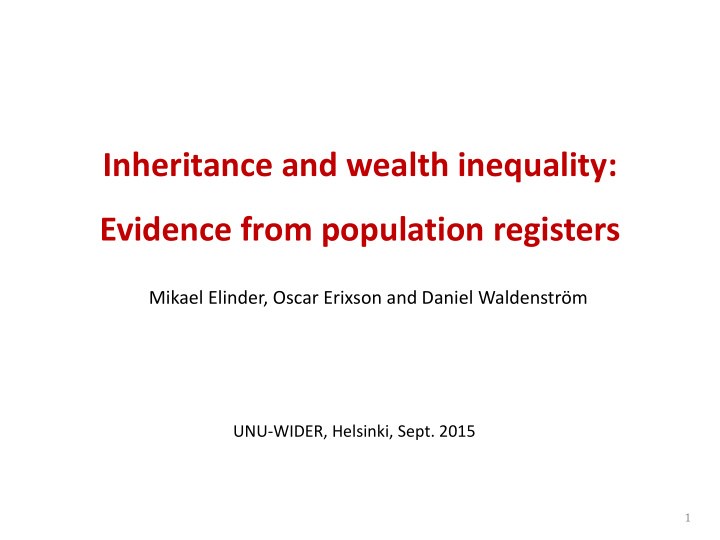



Inheritance and wealth inequality: Evidence from population registers Mikael Elinder, Oscar Erixson and Daniel Waldenström UNU-WIDER, Helsinki, Sept. 2015 1
Starting point • Wealth has become more unequally distributed • Flows of inherited wealth has increased • How do inheritances influence the wealth distribution of heirs? • “ ...Inheritance perpetuates and may intensify inequalities arising originally from other causes. … The extent of its influence on distribution remains an open question, which cannot be decided merely by theoretical reasoning ... but requires in addition something in the nature of a quantitative analysis of the relevant facts. ” Wedgwood, 1929, pp. 60-61. 2
Key advantage: Population wide register data • New Swedish database • All decedents and all their heirs • Inheritance years ( cohorts ): 2002−2005 • Details about estates, inheritances (incl . 0’s), insurances, taxable gifts • Panel data on marketable net worth ( wealth ) of the heirs • Exclude spousal bequests ⇒ Leaves us with: 200,000 decedents and 600,000 heirs 3
What we find • Inheritances are unequally distributed • Inheritances reduce wealth inequality! (I’ll explain why!) • Inheritance taxation plays minor role, but may increase inequality (I’ll explain why!) • Mobility increases: poor move up and rich fall down! 4
Causal effect • DiD: Compare evolution of wealth distributions across cohorts • Cohorts : inherited vs. not yet inherited • Counterfactual is thus not a world without inheritances! 5
The distributions of estates and inheritances SKEWED! Decedent: 82 years Heir: 55 years Estate >200,000 SEK Inheritance <100,000 SEK 10 SEK ≈ 1 Euro 6
The effect of inheriting on the wealth distribution: A graphical analysis Cohort 2002 in 2001 vs. 2003 Cohort 2004 in 2001 vs. 2003 7
The effect of inheriting on… Placebo Cohort 2002 in 1999 vs. 2001 Cohort 2004 in 1999 vs. 2001 8
Development of the Gini coefficient 2002 2003 2004 cohort cohort cohort inherits inherits inherits 9
Why do inheritances reduce wealth inequality? ‒ Relatively more important for the less wealthy! Figure: Inheritance by wealth deciles Relatively more Absolutely more important in the bottom important in the top 10
What is the role of the Swedish inheritance tax? Progressive 𝜐 𝐶 : 0, 10, 20, and 30 percent But, the average, effective tax rate was rarely above 20 percent Finding: The tax may actually have contributed to increased wealth inequality among heirs! Caveats: 1) A more progressive tax may yield a different result 2) Does not account for redistribution of inheritance tax revenues 3) Does not account for popular sentiments towards equalization 11
How can a progressive inheritance tax increase wealth inequality? Figure: Inheritance tax payments by wealth decile 12
Mobility effects Evolution of Shorrocks-Prais index (trace in tr.matrices) 13
Concluding remarks • Inheritances reduce wealth inequality among heirs – Similar results in survey data (e.g. US: Wolff (2002, 2003), Gittleman & Wolff (2014), SWE: Klevmarken (2004) UK: Karagiannaki (2011), Crawford & Hood (2015), Japan: Horrioka (2009) • Limitations/Need for more analysis: – Cannot perfectly account for pre-inheritances responses – …or the impact of all inter vivos gifts – Need to distinguish between lifecycle and inherited wealth of donees? – Inheritance tax analysis still incomplete 14
Descriptives of heirs Cohort: 2002 2003 2004 2005 Age at inheritance 54.5 54.6 54.9 55.1 Child of the decedent (%) 56.7 57.1 55.6 59.4 Woman (%) 50.7 50.5 50.7 50.6 Married (%) 53.8 53.2 52.7 52.3 Upper secondary or post-graduate 24.6 25.4 25.7 26.2 degree (%) Taxable labor income 𝑢 − 1 (SEK) 220,041 224,993 227,687 234,903 Wealth 𝑢 − 1 (SEK) 638,967 590,612 625,364 691,191 Gross inheritance (SEK) 82,520 83,430 88,791 n.a. Net inheritance (SEK) 73,025 73,737 78,131 n.a. Paying inheritance tax (%) 32.9 33.0 34.2 n.a. Have received taxable gifts (%) 1.9 1.9 2.0 n.a. Taxable gifts (SEK) 2,683 2,796 2,866 n.a. 15
Inheritance effects on wealth inequality Outcome: Gini P90/P50 P99/P50 Top1% Top10% Bot. 50% P75-P25 P99-P1 CV Treatment – 0.035*** – 0.601*** – 1.876** – 0.023** – 0.029*** 0.018*** – 4.320 64,998*** 259,586* effect ( 𝜀 ) (0.008) (0.163) (0.831) (0.010) (0.004) (0.005) (3.007) (15,484) (128,255) Mean of y 0.802 6.609 20.618 0.189 0.556 – 0.015 6.79 765,926 5,545,335 Effect in % – 4.36 – 9.10 – 9.10 – 12.70 – 5.21 – – 63.62 8.49 4.68 The direct mechanical effect on Gini: 6 percent reduction 16
Sensitivity analyses • Different inequality measures (CV, Top shares, Percentile ratios): – ineq. effect decreases, but dispersion increases • Adjusting for (potential) undervaluation of assets: same result! • Children heirs only: same result! • Gifts as inheritance in advance: larger effect • Excpectations and pre-inheritance wealth accumulation: little impact 17
Recommend
More recommend